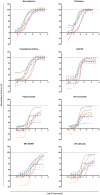Nitroheterocyclic compounds are more efficacious than CYP51 inhibitors against Trypanosoma cruzi: implications for Chagas disease drug discovery and development
- PMID: 24736467
- PMCID: PMC4004771
- DOI: 10.1038/srep04703
Nitroheterocyclic compounds are more efficacious than CYP51 inhibitors against Trypanosoma cruzi: implications for Chagas disease drug discovery and development
Abstract
Advocacy for better drugs and access to treatment has boosted the interest in drug discovery and development for Chagas disease, a chronic infection caused by the genetically heterogeneous parasite, Trypanosoma cruzi. In this work new in vitro assays were used to gain a better understanding of the antitrypanosomal properties of the most advanced antichagasic lead and clinical compounds, the nitroheterocyclics benznidazole, nifurtimox and fexinidazole sulfone, the oxaborole AN4169, and four ergosterol biosynthesis inhibitors--posaconazole, ravuconazole, EPL-BS967 and EPL-BS1246. Two types of assays were developed: one for evaluation of potency and efficacy in dose-response against a panel of T. cruzi stocks representing all current discrete typing units (DTUs), and a time-kill assay. Although less potent, the nitroheterocyclics and the oxaborole showed broad efficacy against all T. cruzi tested and were rapidly trypanocidal, whilst ergosterol biosynthesis inhibitors showed variable activity that was both compound- and strain-specific, and were unable to eradicate intracellular infection even after 7 days of continuous compound exposure at most efficacious concentrations. These findings contest previous reports of variable responses to nitroderivatives among different T. cruzi strains and further challenge the introduction of ergosterol biosynthesis inhibitors as new single chemotherapeutic agents for the treatment of Chagas disease.
Figures



Similar articles
-
In vitro and in vivo studies of the antiparasitic activity of sterol 14α-demethylase (CYP51) inhibitor VNI against drug-resistant strains of Trypanosoma cruzi.Antimicrob Agents Chemother. 2013 Sep;57(9):4151-63. doi: 10.1128/AAC.00070-13. Epub 2013 Jun 17. Antimicrob Agents Chemother. 2013. PMID: 23774435 Free PMC article.
-
Complexes of Trypanosoma cruzi sterol 14α-demethylase (CYP51) with two pyridine-based drug candidates for Chagas disease: structural basis for pathogen selectivity.J Biol Chem. 2013 Nov 1;288(44):31602-15. doi: 10.1074/jbc.M113.497990. Epub 2013 Sep 18. J Biol Chem. 2013. PMID: 24047900 Free PMC article.
-
Successful Aspects of the Coadministration of Sterol 14α-Demethylase Inhibitor VFV and Benznidazole in Experimental Mouse Models of Chagas Disease Caused by the Drug-Resistant Strain of Trypanosoma cruzi.ACS Infect Dis. 2019 Mar 8;5(3):365-371. doi: 10.1021/acsinfecdis.8b00253. Epub 2019 Jan 23. ACS Infect Dis. 2019. PMID: 30625275 Free PMC article.
-
Sterol 14-demethylase inhibitors for Trypanosoma cruzi infections.Adv Exp Med Biol. 2008;625:61-80. doi: 10.1007/978-0-387-77570-8_6. Adv Exp Med Biol. 2008. PMID: 18365659 Review.
-
Clear Shot at Primary Aim: Susceptibility of Trypanosoma cruzi Organelles, Structures and Molecular Targets to Drug Treatment.Curr Top Med Chem. 2017;17(10):1212-1234. doi: 10.2174/1568026616666161025161858. Curr Top Med Chem. 2017. PMID: 27784255 Review.
Cited by
-
Review on Experimental Treatment Strategies Against Trypanosoma cruzi.J Exp Pharmacol. 2021 Mar 31;13:409-432. doi: 10.2147/JEP.S267378. eCollection 2021. J Exp Pharmacol. 2021. PMID: 33833592 Free PMC article. Review.
-
Antitrypanosomal activity of 5-nitro-2-aminothiazole-based compounds.Eur J Med Chem. 2016 Jul 19;117:179-86. doi: 10.1016/j.ejmech.2016.04.010. Epub 2016 Apr 8. Eur J Med Chem. 2016. PMID: 27092415 Free PMC article.
-
Antiprotozoal Activity Profiling of Approved Drugs: A Starting Point toward Drug Repositioning.PLoS One. 2015 Aug 13;10(8):e0135556. doi: 10.1371/journal.pone.0135556. eCollection 2015. PLoS One. 2015. PMID: 26270335 Free PMC article.
-
Development and application of a sensitive, phenotypic, high-throughput image-based assay to identify compound activity against Trypanosoma cruzi amastigotes.Int J Parasitol Drugs Drug Resist. 2015 Dec;5(3):215-28. doi: 10.1016/j.ijpddr.2015.10.001. Epub 2015 Oct 14. Int J Parasitol Drugs Drug Resist. 2015. PMID: 27120069 Free PMC article.
-
Temporal and Wash-Out Studies Identify Medicines for Malaria Venture Pathogen Box Compounds with Fast-Acting Activity against Both Trypanosoma cruzi and Trypanosoma brucei.Microorganisms. 2022 Jun 25;10(7):1287. doi: 10.3390/microorganisms10071287. Microorganisms. 2022. PMID: 35889006 Free PMC article.
References
-
- WHO. Working to overcome the global impact of neglected tropical diseases. Available from http://www.who.int/neglected_diseases/2010report/en/ (2010) (Accessed on 18/02/2014).
-
- Gascon J., Bern C. & Pinazo M.-J. Chagas disease in Spain, the United States and other non-endemic countries. Acta Trop. 115, 22–27 (2010). - PubMed
-
- Bern C. & Montgomery S. P. An estimate of the burden of Chagas disease in the United States. Clin. Infec. Dis. 49, e52–4 (2009). - PubMed
-
- Rassi A. J., Rassi A. & Marcondes de Rezende J. American trypanosomiasis (Chagas disease). Infect. Dis. Clin. North Am. 26, 275–291 (2012). - PubMed
Publication types
MeSH terms
Substances
LinkOut - more resources
Full Text Sources
Other Literature Sources
Medical

